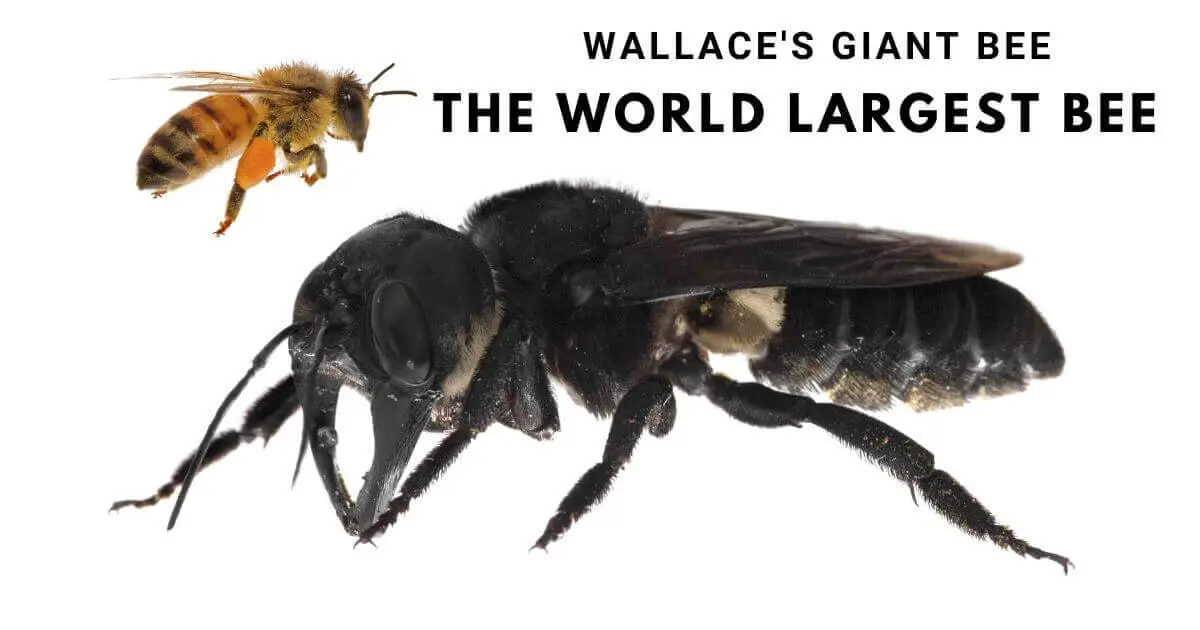The largest bee in the world is the Wallace’s giant bee (Megachile pluto), also known as the “Raja ofu,” which can grow up to 3.9 cm (1.5 inches) in length, with a wingspan of 6.3 cm (2.5 inches). This bee species is native to the Indonesian island of North Moluccas, also known as the Halmahera Islands.
Classifications:
| Phylum | Arthropoda |
| Class | Insecta |
| Order | Hymenoptera |
| Family | Megachilidae |
| Genus | Megachile |
| Species | Megachile pluto |
Habits of Wallace’s giant bee.
Wallace’s giant bee is a solitary bee species that typically lives alone in tree cavities. They constructs its nests using resin and wood particles. This bee species is not aggressive and rarely stings humans. However, like other bees, it has the ability to sting if it feels threatened.
Megachile pluto is an important pollinator of the native flora in its habitat, especially the Amorphophallus titanum, also known as the “corpse flower.” Giant bee species uses its large mandibles to scrape and collect resin from trees, which it then uses to construct its nests and seal the entrances.
Due to habitat loss, Wallace’s giant bee was considered extinct until it was rediscovered in 1981. Since then, efforts have been made to protect this species and its habitat. Wallace’s giant bee is currently listed as “Vulnerable” on the IUCN Red List of Threatened Species.
Interesting Facts about Wallace’s giant bee.
- Wallace’s giant bee is named after the British naturalist Alfred Russel Wallace, who discovered the species in 1858 during his travels in Indonesia.
- The bee’s nesting habits are unique. It constructs its nest in tree cavities by using resin and wood particles, making it one of the few bee species that use resin in its nest construction.
- They are classified as a solitary bee, meaning it lives alone and does not form colonies like honey bees.
- The bee is not aggressive towards humans and rarely stings unless provoked. Its large size and slow movements make it easy to handle.
- Large mandibles that are used for collecting resin, and its black coloration, which is covered with sparse yellowish-white hair.
- Megachile pluto is an important pollinator of the endemic flora in its native habitat, especially the giant corpse flower, which is pollinated by the bee’s large mandibles.
- The bee was feared to be extinct for over a century until it was rediscovered in 1981 by an entomologist named Adam Messer. The bee’s rediscovery sparked renewed interest in its conservation and protection.
Related Articles:
Nesting & Developing Habits.
Wallace’s giant bee, the largest bee in the world, constructs its nests in tree cavities using resin and wood particles. The bee is a solitary species, meaning that it lives alone and does not form colonies like honey bees. Each female bee constructs and maintains its own nest, which it seals with a plug made of resin.
The nest of Megachile pluto consists of a series of individual cells, each of which contains a single egg. The female bee collects pollen and nectar, which it uses to create a mixture that it places in each cell to feed the larva that hatches from the egg. The female bee then seals the cell with a plug of resin, which protects the larva as it develops.
Summary
Wallace’s giant bee is the largest bee in the world, with a length of up to 3.9 cm and a wingspan of 6.3 cm. It is a solitary bee that constructs its nests in tree cavities using resin and wood particles. The bee is an important pollinator of endemic flora, especially the giant corpse flower. Due to habitat loss, it was considered extinct until its rediscovery in 1981, and it is currently listed as “Vulnerable” on the IUCN Red List of Threatened Species.




